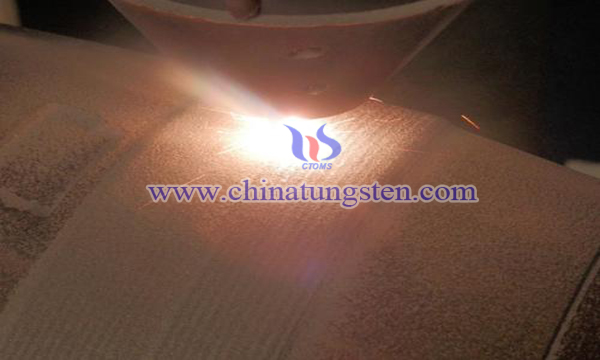Surface Cladding Tungsten Carbide Coating Method
- Details
- Category: Tungsten Information
- Published on Monday, 07 January 2019 22:58
Tungsten carbide is a well-known anti-wear material. For a long time, people have done a lot of research on tungsten carbide materials from practical applications, especially the research on its high-temperature tribological properties has achieved certain results. It is considered to be the most widely used. The development and application of the most promising metal-based composite materials have been used in aviation, aerospace, ordnance, automotive, agricultural machinery, electronics, sports and other industries.

Tungsten carbide cladding on metal substrates generally adopts thermal spraying, plasma spraying, explosive spraying, PVD or CVD, etc. There are many processes. This paper introduces a method of cladding tungsten carbide coatings on the surface of metal substrates, including the following steps:
1.The weight percentage of nickel-based tungsten carbide is 35% of nickel-based alloy powder, 65% of tungsten carbide powder, the particle size of tungsten carbide powder is 30-50 micron, and the particle size of nickel-based alloy powder is 50-100 micron.
2.Put the metal powder in the ball mill mixer and mix evenly for 3 hours.
3.Polytetrafluoroethylene (PTFE) powder with 5% mass of metal powder was added into the mixed metal powder. After mixing, the powder was evenly mixed in the ball mill for 3 hours. Then the powder was rolled into a flat cloth on a multi-roll mill to obtain a cloth-like tungsten carbide coating.
4.After grinding the steel substrate with a machine-processed grinder, it is polished with sandpaper, and the surface is cleaned with alcohol and acetone solution to remove oil stains, and dried in a drying oven.
5.The cloth tungsten carbide cladding is bonded to the surface of the base material with a strong adhesive. The adhesive is evenly and lightly coated between the cladding and the base material, with a thickness not exceeding 0.1 mm.
6.Put the bonded coatings and substrates into the vacuum heat treatment furnace for vacuum evacuation, remove the binder and moisture in the composite bonding coatings, and preheat and dry the samples to avoid the residual moisture reacting with the coatings or substrates at high temperatures. The vacuum degree is less than 10 Pa, the temperature is less than 330 ℃, the heating rate is 2 ℃/min, and the holding time is 5 h.
7.Heating up to 800 ℃ at a heating rate of 5 ℃/min, 3 ℃/min at the second stage and 1150 ℃ at the melting temperature for 8 min.
8.Cooling with the furnace, cooling to 150 ℃, taking out air cooling, then conditioning the cladding. The process includes quenching temperature 840 ("water quenching"), high temperature tempering 560 ("water quenching"), holding for 1 hour and then water cooling out of the furnace.
9. The thickness, porosity and hardness of the coatings are 2 mm, 0.3% and 65 HRA. There is a continuous solid solution diffusion layer between the coatings and the base material, and the interfacial bonding strength is greater than 200 MPa.
The tungsten carbide alloy cladding made on the surface of metal substrates has not only high hardness (hardness can reach more than 60 HRC, porosity is less than 0.5%), but also excellent wear resistance and corrosion resistance. It is especially suitable for improving the surface hardness and wear resistance of metal workpieces to meet the needs of military, marine, mechanical, automotive, aerospace, chemical and other fields. The process is simple and feasible, and is suitable for metal parts with complex shapes.
- Tungsten Carbide Manufacturer & Supplier, Chinatungsten Online: tungsten-carbide.com.cn
- Tungsten News & Prices of China Tungsten Industry Association: www.ctia.com.cn
- Molybdenum News & Price: news.molybdenum.com.cn
- Tel.: 86 592 5129696; Fax: 86 592 5129797; Email: sales@chinatungsten.com



 sales@chinatungsten.com
sales@chinatungsten.com